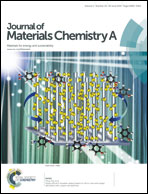PolyTCAQ in organic batteries: enhanced capacity at constant cell potential using two-electron-redox-reactions†
Abstract
The application of polymers bearing tetracyano-9,10-anthraquinonedimethane (TCAQ) units as electrode materials in organic batteries enables one narrow charge discharge plateau due to the one two-electron-redox-reaction of the TCAQ core. Li-organic batteries manufactured with this polymer display repeatable charge–discharge characteristics associated with a capacity of 156 mA h g−1 and a material activity of 97%.


 Please wait while we load your content...
Please wait while we load your content...